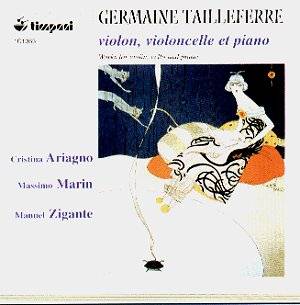This disc brings together works for strings and piano
written between 1913 and 1978 by Germaine Tailleferre. What is remarkable
is the consonance and continuity of technique and expression between
the two extremes, which leads to the reflection that far from "not
developing" in the broadest most concentrated sense Tailleferre
grew to simplify her style but not to divert from its essential core.
Returning, for example, sixty years later to the Trio she had written
in 1917 she remains imaginatively the same composer when she added two
movements to it, movements both sympathetic to and enriching of the
originals. Write Tailleferre off at your peril.
That Trio, composed between 1916 and 1917, opens in
the Gallic hot house with an Allegro animato of richness and
density. The subsequently composed Allegro vivace (from 1978)
is animated and stomping with a vein of wit and a slight antique air
in the aloofly Ravelian mode whilst the third movement Moderato
dates from 1917 and is brief and slight. The finale opens harmoniously
before gathering some momentum - a strong work from 1978. As a pendant
the original 1917 second movement is presented; fleeting like gauze,
flickering but securely anchored by the cello you will reach for the
usual suspects of influence but I found it a subtle movement well deserving
its disinterment. At 538 it would formally and structurally, I suppose,
be said to unbalance the Trio, which in this composite form lasts only
13 and a half minutes. Nevertheless a slice of the muslin Tailleferre.
Her two violin sonatas have been recorded a number
of times before Renata Eggebrecht and Gassenhuber most recently on
Troubadisc TRO-CD 0406, also fearless champions of Ethel Smyth, but
also by Ehrlich and Eckert on Cambria; the Second Sonata has also been
recorded by Arnold Steinhardt and by Roche and Fried on Vox. The First
Sonata of 1921 opens sunnily but a rather more pensive and inward second
subject steals in darkening the mood. The Sonata was written for and
dedicated to Jacques Thibaud and he premiered it with Cortot in June
1922. The work clearly also carries within it an autobiographical charge
because of the relationship between violinist a suave womaniser
and composer. The rhythmically amusing piano writing of the second movement
scherzo runs beneath a lyrical violin line, some teasing little battles
between the two lending a flirtatious air to the movement whilst the
slow movement is dominated by the piano initially before the violin,
musing reflectedly at first begins a more passionate series of episodes.
In the finale there is more of a sense of consonance and solidarity
between violin and piano until the closing moments with a long held
note from the violin and the pianos strange unsettledness beneath until,
just in time, the violin perks up, the piano with it, for a little dance
tune to end the work.
The Second Sonata was derived from the Violin Concerto
of 1936, which was premiered by Yvonne Astruc and Pierre Monteux. Milhaud
liked it and was a known admirer of the violinist who had also premiered
his own work. Tailleferre revised the Concerto for violin and piano
for performance in 1946 and it was subsequently performed by Jeanne
Gautier the notes anglicise her name as Jane and Tailleferre herself
in 1951. Delightfully full of fresh air and uncomplicated the first
movement is avuncular and openhearted and the finale charmingly motoric
with room for quick light trills from violinist Massimo Zigante. The
Sonatine equally has a joyful freshness tinged with moments of
reserve, a light breeze of a work. Elsewhere the early Berceuse
shows her indebtedness to Fauré; the Adagio is a transcription
of her Piano Concerto an affectionately serious movement. The Pastorale
is a rocking, romantic work with an unexpectedly late Romantic profile.
Idiomatic and understanding these performances do Tailleferre
proud. They catch something of her elfin pleasure and also a touching
reserve. Its not surely necessary now to liberate her from the constrictive
notoriety of membership of Les Six; on her own terms she was a lyricist
and romantic, inheritor of Faurés gift for melody but tinged
by her modernist inclinations, and here a composer of still treasurable
generosity.
Jonathan Woolf
